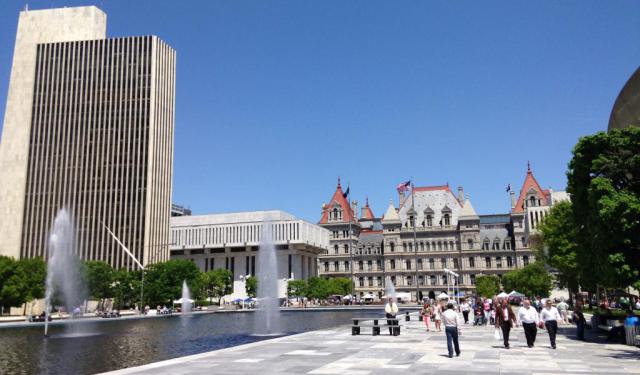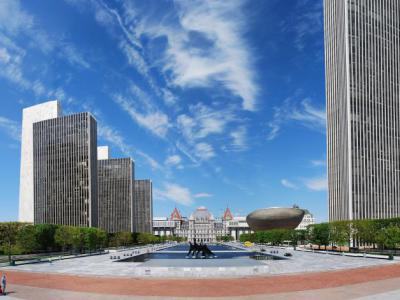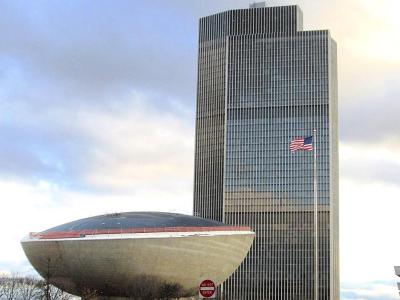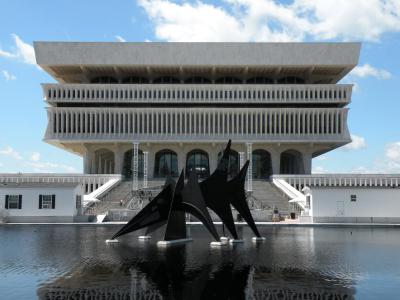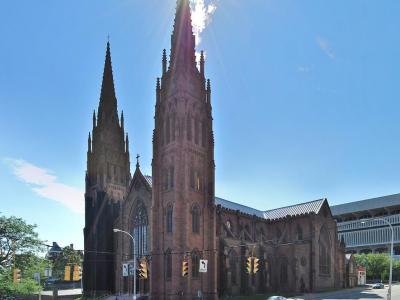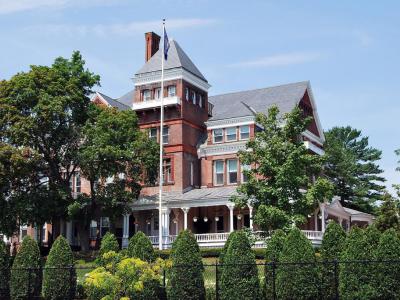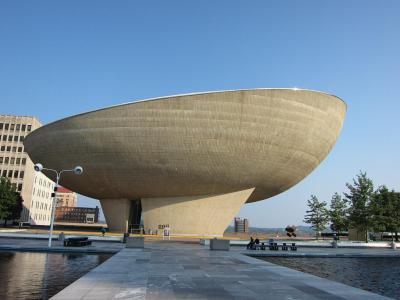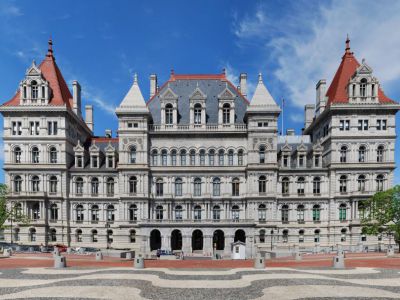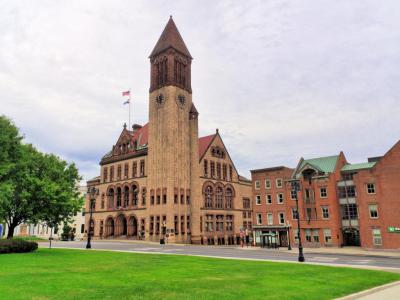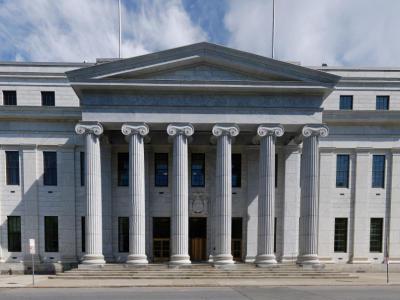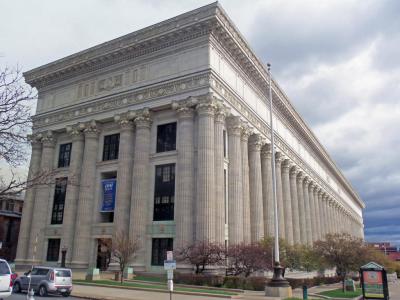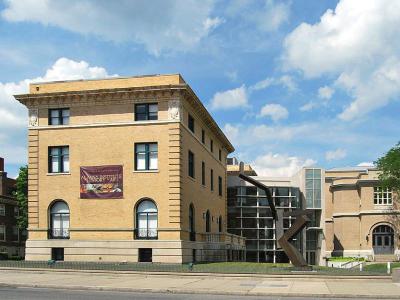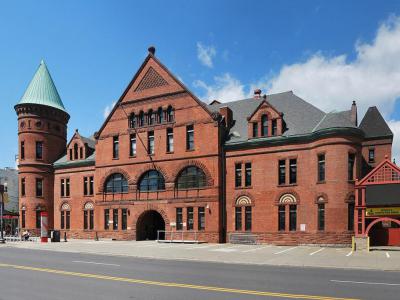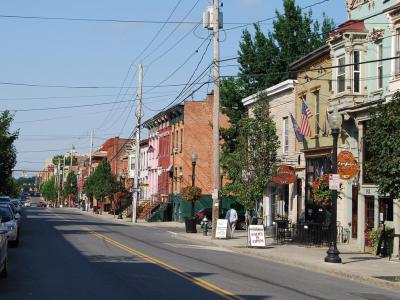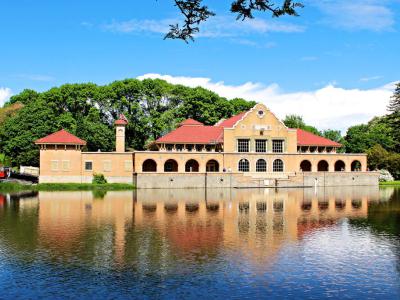Albany Introduction Walking Tour (Self Guided), Albany
Albany, the state capital of New York, is a small city with a storied canvas that holds a significant place in the narrative of New York and the broader United States.
The Hudson River area in which it lies was originally inhabited by the indigenous Mohican people. In 1614, the territory was settled by Dutch colonists. Fifty years later, the English took over the Dutch settlement, renaming it Albany in honor of the Duke of York's Scottish title, the Duke of Albany, who eventually became King James II of England. The city was officially chartered in 1686 and became the capital of New York, in 1797, after the formation of the United States. Albany is the oldest surviving settlement of the original thirteen British colonies north of Virginia; no other US city has been continuously chartered this long.
In the late 18th century and throughout most of the 19th, Albany was a center of trade and transportation, housing some of the earliest railroads in the world. In the early 21st century, its high-technology industry grew, with great strides in nanotechnology.
The historical landscape of Albany is punctuated by striking architecture and culturally significant sites interesting to discover. The Empire State Plaza is a testament to modern governmental might, while the Erastus Corning Tower, the tallest building in New York outside of New York City, offers sweeping views of the Hudson River and beyond. History enthusiasts can delve into the past at the New York State Museum, which houses artifacts that span centuries of the state's history.
Albany's commitment to the arts and education is evident in its numerous institutions. The Egg, a uniquely shaped performance center, is an icon of Albany’s architectural and cultural innovation. The New York State Capitol, a marvel of 19th-century masonry, and Albany City Hall, an example of exquisite Romanesque architecture, both reflect the city's rich governmental legacy.
For those seeking a blend of lively commerce and nightlife, Lark Street, often referred to as “Albany’s Greenwich Village,” provides a colorful array of shops, cafes, and pubs, set against a backdrop of historic buildings. Nearby, Washington Park offers a peaceful retreat with its picturesque lake and well-maintained gardens, a perfect setting for leisurely walks or family picnics.
For those drawn by the allure of history, the beauty of architecture, or the vibrant cultural scene, Albany promises a rich and rewarding experience. So, plan your visit here now and discover the heart of New York in its truest form.
The Hudson River area in which it lies was originally inhabited by the indigenous Mohican people. In 1614, the territory was settled by Dutch colonists. Fifty years later, the English took over the Dutch settlement, renaming it Albany in honor of the Duke of York's Scottish title, the Duke of Albany, who eventually became King James II of England. The city was officially chartered in 1686 and became the capital of New York, in 1797, after the formation of the United States. Albany is the oldest surviving settlement of the original thirteen British colonies north of Virginia; no other US city has been continuously chartered this long.
In the late 18th century and throughout most of the 19th, Albany was a center of trade and transportation, housing some of the earliest railroads in the world. In the early 21st century, its high-technology industry grew, with great strides in nanotechnology.
The historical landscape of Albany is punctuated by striking architecture and culturally significant sites interesting to discover. The Empire State Plaza is a testament to modern governmental might, while the Erastus Corning Tower, the tallest building in New York outside of New York City, offers sweeping views of the Hudson River and beyond. History enthusiasts can delve into the past at the New York State Museum, which houses artifacts that span centuries of the state's history.
Albany's commitment to the arts and education is evident in its numerous institutions. The Egg, a uniquely shaped performance center, is an icon of Albany’s architectural and cultural innovation. The New York State Capitol, a marvel of 19th-century masonry, and Albany City Hall, an example of exquisite Romanesque architecture, both reflect the city's rich governmental legacy.
For those seeking a blend of lively commerce and nightlife, Lark Street, often referred to as “Albany’s Greenwich Village,” provides a colorful array of shops, cafes, and pubs, set against a backdrop of historic buildings. Nearby, Washington Park offers a peaceful retreat with its picturesque lake and well-maintained gardens, a perfect setting for leisurely walks or family picnics.
For those drawn by the allure of history, the beauty of architecture, or the vibrant cultural scene, Albany promises a rich and rewarding experience. So, plan your visit here now and discover the heart of New York in its truest form.
How it works: Download the app "GPSmyCity: Walks in 1K+ Cities" from Apple App Store or Google Play Store to your mobile phone or tablet. The app turns your mobile device into a personal tour guide and its built-in GPS navigation functions guide you from one tour stop to next. The app works offline, so no data plan is needed when traveling abroad.
Albany Introduction Walking Tour Map
Guide Name: Albany Introduction Walking Tour
Guide Location: USA » Albany (See other walking tours in Albany)
Guide Type: Self-guided Walking Tour (Sightseeing)
# of Attractions: 15
Tour Duration: 3 Hour(s)
Travel Distance: 3.9 Km or 2.4 Miles
Author: Maia
Sight(s) Featured in This Guide:
Guide Location: USA » Albany (See other walking tours in Albany)
Guide Type: Self-guided Walking Tour (Sightseeing)
# of Attractions: 15
Tour Duration: 3 Hour(s)
Travel Distance: 3.9 Km or 2.4 Miles
Author: Maia
Sight(s) Featured in This Guide:
- Empire State Plaza
- Erastus Corning Tower
- New York State Museum
- Cathedral of the Immaculate Conception
- New York State Executive Mansion
- The Egg
- New York State Capitol
- Albany City Hall
- New York Court of Appeals Building
- Old Albany Academy Building
- New York State Education Building
- Albany Institute of History & Art
- Washington Avenue Armory
- Lark Street
- Washington Park
1) Empire State Plaza (must see)
The Empire State Plaza, officially known as the Governor Nelson A. Rockefeller Empire State Plaza, is a striking and iconic capital center. Conceived by Governor Nelson A. Rockefeller, the Plaza was designed to be "the most electrifying capital in the world." Rockefeller's vision was brought to life by Wallace K. Harrison, a prominent architect and Rockefeller's personal friend, who was also the chief architect for Rockefeller Center. Construction of the Plaza began in 1965 and was completed in 1978, resulting in a cultural and architectural landmark that attracts thousands of visitors annually.
The Empire State Plaza is a marvel of Modern architecture, consisting of several steel and reinforced concrete buildings clad in imported stone. The only exception is The Egg, a performing arts venue that fully exposes its concrete structure and stands as a Brutalist contrast to the International Style of the other buildings. The entire complex is elevated on a six-story stone-clad Main Platform, supported by over 25,000 steel pilings driven deep into the soft glacial clay beneath. The design of the buildings, with their exterior columns and narrow windows, draws a visual connection to the World Trade Center towers in New York City, which were constructed around the same time.
The sheer scale of the Empire State Plaza is imposing, making it a dominant feature of Albany's skyline. The 44-story Corning Tower, the tallest building in New York State outside of New York City, includes an observation deck on its 42nd floor that offers panoramic views. The Main Platform of the Plaza is one of the largest buildings globally, incorporating 240,000,000 cubic feet of concrete and 600,000 cubic feet of stone sourced from three continents. The Swan Street Building, notable for its length exceeding a quarter of a mile, is inspired by the ancient Egyptian Temple of Hatshepsut at Deir el-Bahri.
Beyond its architectural grandeur, the Empire State Plaza serves as a vibrant cultural hub. It hosts various events and exhibitions throughout the year, and during the winter months, one of the Plaza's reflecting pools transforms into an outdoor ice skating rink, adding to its community appeal.
The Empire State Plaza is a marvel of Modern architecture, consisting of several steel and reinforced concrete buildings clad in imported stone. The only exception is The Egg, a performing arts venue that fully exposes its concrete structure and stands as a Brutalist contrast to the International Style of the other buildings. The entire complex is elevated on a six-story stone-clad Main Platform, supported by over 25,000 steel pilings driven deep into the soft glacial clay beneath. The design of the buildings, with their exterior columns and narrow windows, draws a visual connection to the World Trade Center towers in New York City, which were constructed around the same time.
The sheer scale of the Empire State Plaza is imposing, making it a dominant feature of Albany's skyline. The 44-story Corning Tower, the tallest building in New York State outside of New York City, includes an observation deck on its 42nd floor that offers panoramic views. The Main Platform of the Plaza is one of the largest buildings globally, incorporating 240,000,000 cubic feet of concrete and 600,000 cubic feet of stone sourced from three continents. The Swan Street Building, notable for its length exceeding a quarter of a mile, is inspired by the ancient Egyptian Temple of Hatshepsut at Deir el-Bahri.
Beyond its architectural grandeur, the Empire State Plaza serves as a vibrant cultural hub. It hosts various events and exhibitions throughout the year, and during the winter months, one of the Plaza's reflecting pools transforms into an outdoor ice skating rink, adding to its community appeal.
2) Erastus Corning Tower
The Erastus Corning Tower, also known as the Mayor Erastus Corning 2nd Tower, is a prominent skyscraper. Completed in 1966, the tower is part of the Empire State Plaza and stands at an impressive 589 feet, making it the tallest building in the state outside of New York City. The structure is sheathed in Vermont Pearl marble and glass, contributing to its sleek and modern appearance. It serves as a state office building, housing the New York State Department of Health and the New York State Office of General Services.
One of the Corning Tower's most notable features is its observation deck on the 42nd floor. This vantage point offers expansive views of Albany, the Hudson River, and the surrounding region. Informative panels below the windows help visitors identify and learn about visible landmarks. While the observation deck does not provide a full 360-degree view-lacking windows on the west side-it remains a popular spot for both locals and tourists. Visitors can reach the deck via a nonstop elevator that travels at a speed of 26 km/h (16 MPH).
In addition to its architectural significance, the Corning Tower has played a role in making the Albany skyline recognizable. For a period from 2000 to 2004, it was listed in the World Almanac's list of "Other Tall Buildings in North American Cities," highlighting its prominence. The building's public access policies have also evolved over time; notably, upon taking office in 2010, Governor Andrew Cuomo eliminated the requirement for visitors to present a photo ID to access the observation deck, making it more accessible to the public.
One of the Corning Tower's most notable features is its observation deck on the 42nd floor. This vantage point offers expansive views of Albany, the Hudson River, and the surrounding region. Informative panels below the windows help visitors identify and learn about visible landmarks. While the observation deck does not provide a full 360-degree view-lacking windows on the west side-it remains a popular spot for both locals and tourists. Visitors can reach the deck via a nonstop elevator that travels at a speed of 26 km/h (16 MPH).
In addition to its architectural significance, the Corning Tower has played a role in making the Albany skyline recognizable. For a period from 2000 to 2004, it was listed in the World Almanac's list of "Other Tall Buildings in North American Cities," highlighting its prominence. The building's public access policies have also evolved over time; notably, upon taking office in 2010, Governor Andrew Cuomo eliminated the requirement for visitors to present a photo ID to access the observation deck, making it more accessible to the public.
3) New York State Museum (must see)
The New York State Museum is a premier educational institution rich with diverse collections that reflect the cultural, natural, and geological heritage of New York State. Established in 1836, it is the nation's oldest and largest state museum. Its current modern building, which has been in use since 1976, is part of the Cultural Education Center. This move from its former location in the State Education Building allowed the museum to expand and enhance its exhibitions and programs.
The museum's vast collections include art, artifacts from both prehistoric and historic periods, and ecofacts that provide insight into the state's extensive history and natural environment. Operated by the New York State Education Department's Office of Cultural Education, the museum occupies the first four floors of the Cultural Education Center.
Among the museum's notable features are its anthropological collections, which are among the most extensive in the country. These collections include contributions from prominent anthropologists such as Lewis H. Morgan and Arthur C. Parker, and are available for research and analysis. The museum's exhibits, such as "Birds of New York" and "Ancient Life of New York - A Billion Years of Earth History," provide engaging and informative displays for visitors of all ages.
The museum's vast collections include art, artifacts from both prehistoric and historic periods, and ecofacts that provide insight into the state's extensive history and natural environment. Operated by the New York State Education Department's Office of Cultural Education, the museum occupies the first four floors of the Cultural Education Center.
Among the museum's notable features are its anthropological collections, which are among the most extensive in the country. These collections include contributions from prominent anthropologists such as Lewis H. Morgan and Arthur C. Parker, and are available for research and analysis. The museum's exhibits, such as "Birds of New York" and "Ancient Life of New York - A Billion Years of Earth History," provide engaging and informative displays for visitors of all ages.
4) Cathedral of the Immaculate Conception
Established in 1852, the Cathedral of the Immaculate Conception Roman Catholic cathedral serves as the mother church of the Diocese of Albany. The cathedral, listed on the National Register of Historic Places in 1976, was designed by the prominent Irish American architect Patrick Keely.
Keely's Gothic Revival design aimed to accommodate Albany's burgeoning population of Catholic immigrants, making it the second-oldest cathedral in New York State, following Saint Patrick's Cathedral in New York City. It is also notable for being the third-oldest Catholic cathedral in the United States and the first American Catholic cathedral to be built in the Neo-Gothic style.
One of the cathedral's most striking features is its twin spires, which have become symbolic of New York's capital city. These spires, however, were not constructed simultaneously. The north tower was completed in 1862, and the south tower followed in 1888. In the same year as the completion of the north tower, one of the cathedral's bishops blessed its bells, adding to the spiritual and communal significance of the structure. The interior of the cathedral houses a crypt containing the coffins of six of Bishop Howard Hubbard's predecessors, adding a historical and sacred dimension to the building.
The Cathedral of the Immaculate Conception underwent significant renovations in May 2010, that have helped preserve the cathedral's intricate Gothic details and its role as a cornerstone of the Catholic community in Albany.
Keely's Gothic Revival design aimed to accommodate Albany's burgeoning population of Catholic immigrants, making it the second-oldest cathedral in New York State, following Saint Patrick's Cathedral in New York City. It is also notable for being the third-oldest Catholic cathedral in the United States and the first American Catholic cathedral to be built in the Neo-Gothic style.
One of the cathedral's most striking features is its twin spires, which have become symbolic of New York's capital city. These spires, however, were not constructed simultaneously. The north tower was completed in 1862, and the south tower followed in 1888. In the same year as the completion of the north tower, one of the cathedral's bishops blessed its bells, adding to the spiritual and communal significance of the structure. The interior of the cathedral houses a crypt containing the coffins of six of Bishop Howard Hubbard's predecessors, adding a historical and sacred dimension to the building.
The Cathedral of the Immaculate Conception underwent significant renovations in May 2010, that have helped preserve the cathedral's intricate Gothic details and its role as a cornerstone of the Catholic community in Albany.
5) New York State Executive Mansion
The New York State Executive Mansion serves as the official residence for the Governor of New York. This distinguished Italianate building, originally constructed in 1856 as a private home for a banker, has housed 31 governors and their families. The mansion's history as the governor's residence began with Samuel Tilden, who became the first governor to reside there in 1875. Since then, it has been continuously occupied by successive governors, making it a significant site of political and historical importance.
The mansion has a storied history of hosting numerous prominent figures. Distinguished guests have included Presidents Harry Truman, William McKinley, and William Taft; international dignitaries such as the King and Queen of Denmark and Prime Minister Golda Meir; and other notable personalities like Senator Robert Kennedy, Albert Einstein, Eve Curie, and Admiral Richard Byrd. The Princess Suite, named after Princess Beatrix of the Netherlands who stayed there in 1959, reflects the mansion's tradition of hospitality and its role in international diplomacy.
The Executive Mansion is not just a residence but also a hub for gubernatorial business and state affairs. Governors frequently hold meetings with officials in the mansion and maintain a private office on the second floor. The mansion serves as a venue for receiving and entertaining dignitaries, underscoring its role as a site of significant political and social activity. A notable tradition associated with the mansion is the swearing-in ceremony of newly elected governors. This ceremony, typically held in the Drawing Room on New Year’s Eve, ensures a seamless transition of leadership before the official Inauguration Day on January 1st.
The mansion has a storied history of hosting numerous prominent figures. Distinguished guests have included Presidents Harry Truman, William McKinley, and William Taft; international dignitaries such as the King and Queen of Denmark and Prime Minister Golda Meir; and other notable personalities like Senator Robert Kennedy, Albert Einstein, Eve Curie, and Admiral Richard Byrd. The Princess Suite, named after Princess Beatrix of the Netherlands who stayed there in 1959, reflects the mansion's tradition of hospitality and its role in international diplomacy.
The Executive Mansion is not just a residence but also a hub for gubernatorial business and state affairs. Governors frequently hold meetings with officials in the mansion and maintain a private office on the second floor. The mansion serves as a venue for receiving and entertaining dignitaries, underscoring its role as a site of significant political and social activity. A notable tradition associated with the mansion is the swearing-in ceremony of newly elected governors. This ceremony, typically held in the Drawing Room on New Year’s Eve, ensures a seamless transition of leadership before the official Inauguration Day on January 1st.
6) The Egg (must see)
The Egg stands as a unique and iconic performing arts venue in Albany, New York, renowned for its distinctive architectural design resembling, as its name suggests, an egg. Designed by Harrison & Abramovitz as part of the Empire State Plaza project, construction of The Egg spanned from 1966 to 1978, and it occupies the northeast corner of the Plaza. Its unusual shape and central location have made it an emblematic landmark of New York's Capital District.
The Egg's design incorporates a slight inclination and a small pedestal on which it appears to rest. However, the building is ingeniously supported by a stem that extends six stories into the Plaza, with a concrete girdle encircling it to maintain its shape and distribute its weight to the pedestal. Despite its unconventional structure, The Egg houses two functional amphitheaters: the intimate 450-seat Lewis A. Swyer Theatre and the larger 982-seat Kitty Carlisle Hart Theatre.
The Egg's versatile facilities attract a diverse array of performing acts, ranging from music and dance to traditional stage presentations. Its calendar boasts performances by acclaimed artists and groups such as Henry Rollins, New York City Ballet, Emmylou Harris, and They Might Be Giants, among many others. This vibrant venue serves as a cultural hub, bringing together audiences and performers from various genres and backgrounds to celebrate the arts in the heart of Albany.
The Egg's design incorporates a slight inclination and a small pedestal on which it appears to rest. However, the building is ingeniously supported by a stem that extends six stories into the Plaza, with a concrete girdle encircling it to maintain its shape and distribute its weight to the pedestal. Despite its unconventional structure, The Egg houses two functional amphitheaters: the intimate 450-seat Lewis A. Swyer Theatre and the larger 982-seat Kitty Carlisle Hart Theatre.
The Egg's versatile facilities attract a diverse array of performing acts, ranging from music and dance to traditional stage presentations. Its calendar boasts performances by acclaimed artists and groups such as Henry Rollins, New York City Ballet, Emmylou Harris, and They Might Be Giants, among many others. This vibrant venue serves as a cultural hub, bringing together audiences and performers from various genres and backgrounds to celebrate the arts in the heart of Albany.
7) New York State Capitol (must see)
The New York State Capitol stands as an architectural marvel, embodying the grandeur and elegance of 19th-century design. Constructed between 1867 and 1899 at a staggering cost of $25 million, it was the most expensive government building of its time, showcasing a blend of Renaissance, Romanesque, and French Renaissance Revival styles. The Capitol's intricate carvings and elaborate decorations reflect the craftsmanship of its era, making it a standout landmark in the city.
As the seat of the New York State Legislature, the Capitol holds a significant place in both state and national history. Listed on the National Register of Historic Places in 1971 and designated as a National Historic Landmark, it has witnessed countless pivotal moments and decisions that have shaped the course of governance in New York. From its imposing exterior to its opulent interior, the Capitol offers visitors a glimpse into the state's rich political heritage.
Visitors to the Capitol can explore its magnificent grounds and admire its architectural splendor. The building's interior features stunning attractions, including a breathtaking staircase worth one million dollars, the grand Senate Room adorned with exquisite woodwork and stained glass decorations, and a sculpture garden showcasing artistic masterpieces. Guided tours are available to the public, providing insight into the building's history, architectural significance, and role in shaping New York's governance.
As the seat of the New York State Legislature, the Capitol holds a significant place in both state and national history. Listed on the National Register of Historic Places in 1971 and designated as a National Historic Landmark, it has witnessed countless pivotal moments and decisions that have shaped the course of governance in New York. From its imposing exterior to its opulent interior, the Capitol offers visitors a glimpse into the state's rich political heritage.
Visitors to the Capitol can explore its magnificent grounds and admire its architectural splendor. The building's interior features stunning attractions, including a breathtaking staircase worth one million dollars, the grand Senate Room adorned with exquisite woodwork and stained glass decorations, and a sculpture garden showcasing artistic masterpieces. Guided tours are available to the public, providing insight into the building's history, architectural significance, and role in shaping New York's governance.
8) Albany City Hall
Albany City Hall, the grand epicenter of local government, is a striking architectural gem designed by the renowned architect Henry Hobson Richardson. Completed in 1883, the building is celebrated for its architectural beauty and historical significance. Recognized by critics as one of America's most beautiful buildings, it earned a place on the National Register of Historic Places in 1972. Richardson's design features a towering 202-foot structure, crowned by a 50 square-foot chamber offering panoramic views of the city below.
A unique and notable feature of Albany City Hall is its carillon, a musical instrument consisting of 49 bells, ranging in size from 11,200 pounds to a mere 27 pounds. The idea for this carillon was proposed by William Gorham Rice in 1918 as a tribute to soldiers who lost their lives in World War I. Unlike most carillons, which are typically owned by churches or universities, Albany's carillon is one of the few municipal carillons in the United States, making it a true people's instrument. It is also distinguished as one of just 116 concert-class carillons in the country, known for the rich and distinct sounds each bell produces.
The carillonneur, the skilled musician who plays the carillon, operates the instrument from an enclosed room just below the bells. The best locations to enjoy the carillon's harmonious melodies are in Corning Park, situated behind City Hall, or in Academy Park, in front of the building. These spots provide an ideal acoustic environment to appreciate the full range of the carillon's sound.
A unique and notable feature of Albany City Hall is its carillon, a musical instrument consisting of 49 bells, ranging in size from 11,200 pounds to a mere 27 pounds. The idea for this carillon was proposed by William Gorham Rice in 1918 as a tribute to soldiers who lost their lives in World War I. Unlike most carillons, which are typically owned by churches or universities, Albany's carillon is one of the few municipal carillons in the United States, making it a true people's instrument. It is also distinguished as one of just 116 concert-class carillons in the country, known for the rich and distinct sounds each bell produces.
The carillonneur, the skilled musician who plays the carillon, operates the instrument from an enclosed room just below the bells. The best locations to enjoy the carillon's harmonious melodies are in Corning Park, situated behind City Hall, or in Academy Park, in front of the building. These spots provide an ideal acoustic environment to appreciate the full range of the carillon's sound.
9) New York Court of Appeals Building
The New York Court of Appeals Building, officially known as Court of Appeals Hall, is an elegant stone Greek Revival structure. Built in 1842, the building was designed by Henry Rector, showcasing a classic Greek Revival style that includes capitals and bases of columns modeled after the ancient Greek Temple of Nike Apteros on the Acropolis. This architectural choice reflects the grandeur and solemnity befitting the state's highest court.
Originally named State Hall, the building housed state offices and clerks for the court, which convened in the state capitol. In 1916, these offices were relocated, and the building was remodeled to serve as the home of the Court of Appeals. State Architect Lewis F. Pilcher oversaw the addition of a rear extension, into which the ornate courtroom, designed by Henry Hobson Richardson in 1881, was moved from the Capitol's third floor. The courtroom is renowned for its hand-carved oak paneling, intricate furniture, and a striking marble and Mexican onyx fireplace, making it one of the most exquisite governmental chambers of the nineteenth century.
Listed on the National Register of Historic Places in 1971, the Court of Appeals Building is one of seven state supreme court buildings in the United States with such recognition. Rector's design, incorporating all three classical orders in the building's rotunda and utilizing stone arches for ceiling support as an early fireproofing measure, highlights his architectural prowess. This building is one of only two surviving structures known to have been designed by Rector, emphasizing its unique historical and architectural significance.
Situated in a neighborhood characterized by similarly grand buildings, many of which are governmental or institutional and contribute to their historic districts, the Court of Appeals Building stands as a prominent landmark.
Originally named State Hall, the building housed state offices and clerks for the court, which convened in the state capitol. In 1916, these offices were relocated, and the building was remodeled to serve as the home of the Court of Appeals. State Architect Lewis F. Pilcher oversaw the addition of a rear extension, into which the ornate courtroom, designed by Henry Hobson Richardson in 1881, was moved from the Capitol's third floor. The courtroom is renowned for its hand-carved oak paneling, intricate furniture, and a striking marble and Mexican onyx fireplace, making it one of the most exquisite governmental chambers of the nineteenth century.
Listed on the National Register of Historic Places in 1971, the Court of Appeals Building is one of seven state supreme court buildings in the United States with such recognition. Rector's design, incorporating all three classical orders in the building's rotunda and utilizing stone arches for ceiling support as an early fireproofing measure, highlights his architectural prowess. This building is one of only two surviving structures known to have been designed by Rector, emphasizing its unique historical and architectural significance.
Situated in a neighborhood characterized by similarly grand buildings, many of which are governmental or institutional and contribute to their historic districts, the Court of Appeals Building stands as a prominent landmark.
10) Old Albany Academy Building
The Old Albany Academy Building, a distinguished federal-style brownstone, stands as the oldest public building in Albany. Constructed in 1815, it initially served as the home of the Albany Academy, a prominent college preparatory school. During the 1820s and 1830s, Albany was the tenth-largest city in the United States, and the Albany Academy was the largest institution of its kind, reflecting the city's significant educational aspirations and its role in fostering academic excellence.
Throughout its early years, the Old Albany Academy Building was a beacon of learning, educating numerous students who would go on to make significant contributions to various fields. The building's architectural elegance and historical significance have made it a cherished landmark in Albany. Despite the school's relocation in the 1930s, the structure's educational legacy continued to resonate throughout the city.
Today, the Old Albany Academy Building serves as the headquarters of the Albany City Schools, symbolizing the enduring commitment to education within the community. Its continued use in the educational sector underscores the building's importance as a historical and functional asset to the city. The adaptation of this historic structure for modern administrative purposes illustrates the city's dedication to preserving its architectural heritage while accommodating contemporary needs.
In recognition of its architectural and historical value, the Old Albany Academy Building was added to the National Register of Historic Places in 1971.
Throughout its early years, the Old Albany Academy Building was a beacon of learning, educating numerous students who would go on to make significant contributions to various fields. The building's architectural elegance and historical significance have made it a cherished landmark in Albany. Despite the school's relocation in the 1930s, the structure's educational legacy continued to resonate throughout the city.
Today, the Old Albany Academy Building serves as the headquarters of the Albany City Schools, symbolizing the enduring commitment to education within the community. Its continued use in the educational sector underscores the building's importance as a historical and functional asset to the city. The adaptation of this historic structure for modern administrative purposes illustrates the city's dedication to preserving its architectural heritage while accommodating contemporary needs.
In recognition of its architectural and historical value, the Old Albany Academy Building was added to the National Register of Historic Places in 1971.
11) New York State Education Building
The New York State Education Building, an architectural marvel in Albany, was designed by the esteemed architect Henry Hornbostel, a native of New York City. Completed in 1912, this building holds the distinction of being the first major structure in the United States constructed specifically as a headquarters for the administration of education. Its grand front façade is adorned with a 36-column colonnade, one of the longest in the world, designed to set the Education Building apart from the other government edifices on Capitol Hill. These towering columns, each 90 feet in height, are made of Vermont marble, contributing to the building's stately and distinguished appearance.
Adding to its grandeur, the front stairs of the Education Building feature two large sculptures with educational themes, created by renowned New York City sculptor Charles Keck. Known for his numerous historical sculptures across the United States, Keck's works enhance the building's educational and historical significance. Inside, Chancellors Hall, originally called "The Auditorium," is a notable feature. Located on the ground floor and spanning two stories, it includes a gallery and promenade on three sides, reflecting the building's comprehensive and grandiose design.
Upon entering the building from Washington Avenue, visitors are greeted by a wide marble staircase leading to the second floor, where a breathtaking Rotunda extends all the way to the roof. This Rotunda is adorned with large murals depicting the quest for Enlightenment, created by Albany native Will H. Low, who studied art at the same institution as Hornbostel. The Rotunda also features additional columns, further emphasizing Hornbostel's classical design aesthetic. The centerpiece of the Rotunda is a stunning chandelier, 75 feet in length and plated in aluminum leaf, adding a touch of opulence to the already magnificent space.
Adding to its grandeur, the front stairs of the Education Building feature two large sculptures with educational themes, created by renowned New York City sculptor Charles Keck. Known for his numerous historical sculptures across the United States, Keck's works enhance the building's educational and historical significance. Inside, Chancellors Hall, originally called "The Auditorium," is a notable feature. Located on the ground floor and spanning two stories, it includes a gallery and promenade on three sides, reflecting the building's comprehensive and grandiose design.
Upon entering the building from Washington Avenue, visitors are greeted by a wide marble staircase leading to the second floor, where a breathtaking Rotunda extends all the way to the roof. This Rotunda is adorned with large murals depicting the quest for Enlightenment, created by Albany native Will H. Low, who studied art at the same institution as Hornbostel. The Rotunda also features additional columns, further emphasizing Hornbostel's classical design aesthetic. The centerpiece of the Rotunda is a stunning chandelier, 75 feet in length and plated in aluminum leaf, adding a touch of opulence to the already magnificent space.
12) Albany Institute of History & Art
The Albany Institute of History & Art, established in 1791, is one of the oldest museums in the United States, dedicated to collecting, preserving, interpreting, and promoting interest in the history, art, and culture of Albany and the Upper Hudson Valley region. This venerable institution houses a remarkable and extensive collection of over 20,000 objects spanning various genres, including architecture, fashion, photography, and historical artifacts.
The museum's library is equally impressive, containing 140,000 printed volumes and 85,000 photographs. These vast collections provide invaluable resources for researchers and history enthusiasts alike. The Albany Institute supplements its permanent exhibits with a range of traveling exhibitions each year, ensuring a dynamic and ever-evolving visitor experience. Notable permanent exhibits include "19th Century American Sculpture" and "Ancient Egypt," which offer in-depth explorations of these fascinating subjects.
In addition to its exhibits, the Albany Institute of History & Art features a gift shop where visitors can purchase unique items for friends and family, making it a perfect destination for those seeking to bring a piece of history home.
The museum's library is equally impressive, containing 140,000 printed volumes and 85,000 photographs. These vast collections provide invaluable resources for researchers and history enthusiasts alike. The Albany Institute supplements its permanent exhibits with a range of traveling exhibitions each year, ensuring a dynamic and ever-evolving visitor experience. Notable permanent exhibits include "19th Century American Sculpture" and "Ancient Egypt," which offer in-depth explorations of these fascinating subjects.
In addition to its exhibits, the Albany Institute of History & Art features a gift shop where visitors can purchase unique items for friends and family, making it a perfect destination for those seeking to bring a piece of history home.
13) Washington Avenue Armory
The Washington Avenue Armory, officially known as the Washington Avenue Armory Sports and Convention Arena, is a prominent multipurpose arena. With a rich history dating back to its construction in 1890, the Armory was initially built for the Tenth Battalion of the New York National Guard and was designed by the notable state architect Isaac Perry. The venue boasts a significant capacity, accommodating up to 4,300 attendees for concerts and conventions, and 3,600 for sports events, making it a central hub for various activities and gatherings in the region.
Over the years, the Armory has been home to several basketball teams, including the Albany Legends of the International Basketball League and the Albany Patroons, who played in both the Continental Basketball Association and the United States Basketball League. This storied venue continues to serve the community, now hosting the Albany All Stars Roller Derby, the Capital Region's original all-girl roller derby team, highlighting its ongoing relevance and adaptability as a sports and entertainment venue.
The Washington Avenue Armory is notable not only for its functional versatility but also for its architectural significance and historical value. Its historical significance was recognized when it was listed on the National Register of Historic Places on March 2, 1995.
Constructed entirely of brick with brownstone trim sourced from East Longmeadow, Massachusetts, the Washington Avenue Armory exemplifies the Romanesque architectural style. This design choice, common for public buildings in the late 19th century, particularly state armories, imbued the structure with the appearance of a medieval castle. The Romanesque style was more than just an aesthetic preference; it conveyed a sense of strength and authority, essential for buildings associated with government and military functions.
Over the years, the Armory has been home to several basketball teams, including the Albany Legends of the International Basketball League and the Albany Patroons, who played in both the Continental Basketball Association and the United States Basketball League. This storied venue continues to serve the community, now hosting the Albany All Stars Roller Derby, the Capital Region's original all-girl roller derby team, highlighting its ongoing relevance and adaptability as a sports and entertainment venue.
The Washington Avenue Armory is notable not only for its functional versatility but also for its architectural significance and historical value. Its historical significance was recognized when it was listed on the National Register of Historic Places on March 2, 1995.
Constructed entirely of brick with brownstone trim sourced from East Longmeadow, Massachusetts, the Washington Avenue Armory exemplifies the Romanesque architectural style. This design choice, common for public buildings in the late 19th century, particularly state armories, imbued the structure with the appearance of a medieval castle. The Romanesque style was more than just an aesthetic preference; it conveyed a sense of strength and authority, essential for buildings associated with government and military functions.
14) Lark Street
Lark Street is a historic and vibrant corridor that traverses the Arbor Hill, Sheridan Hollow, Center Square, Park South, and Hudson/Park neighborhoods. Known for its eclectic mix of independently owned shops, coffee houses, restaurants, art galleries, antique shops, marketing agencies, bars, and tattoo shops, Lark Street has become a cultural hub in the city.
A significant contributor to Lark Street's cultural landscape is the Upstate Artists Guild (UAG), which has been instrumental in attracting more galleries and studios to downtown Albany and Troy. Their efforts, along with those of other artists and organizations, have transformed many of Lark Street's historic apartment buildings into vibrant galleries and studios. This creative atmosphere is enhanced by the variety of shops offering contemporary art, antiques, jewelry, vintage clothing, flowers, books, and wine, many of which are tucked into charming basement-level or second-story storefronts.
Lark Street's culinary scene is equally diverse, featuring an array of restaurants and eateries that serve Tex-Mex, Greek, Thai, Indian, Hunan, Italian, and Japanese cuisine. Notably, the original Bombers Burrito Bar franchise is a beloved fixture on Lark Street. Additionally, the nearby Washington Avenue Armory at the corner of Lark Street and Washington Avenue adds to the area's vibrancy by hosting various sporting events and rock concerts, making it a focal point for entertainment.
The street's rich musical heritage is evident in the frequent performances by prominent local musicians, such as jazz saxophonist and bandleader Brian Patneaude, Thomasina Winslow, her late father Tom Winslow, and the band Sirsy. The eba Theater, located at 351 Hudson Avenue, is one of the oldest buildings on Lark Street and serves as a testament to the street's long-standing connection to the arts.
A significant contributor to Lark Street's cultural landscape is the Upstate Artists Guild (UAG), which has been instrumental in attracting more galleries and studios to downtown Albany and Troy. Their efforts, along with those of other artists and organizations, have transformed many of Lark Street's historic apartment buildings into vibrant galleries and studios. This creative atmosphere is enhanced by the variety of shops offering contemporary art, antiques, jewelry, vintage clothing, flowers, books, and wine, many of which are tucked into charming basement-level or second-story storefronts.
Lark Street's culinary scene is equally diverse, featuring an array of restaurants and eateries that serve Tex-Mex, Greek, Thai, Indian, Hunan, Italian, and Japanese cuisine. Notably, the original Bombers Burrito Bar franchise is a beloved fixture on Lark Street. Additionally, the nearby Washington Avenue Armory at the corner of Lark Street and Washington Avenue adds to the area's vibrancy by hosting various sporting events and rock concerts, making it a focal point for entertainment.
The street's rich musical heritage is evident in the frequent performances by prominent local musicians, such as jazz saxophonist and bandleader Brian Patneaude, Thomasina Winslow, her late father Tom Winslow, and the band Sirsy. The eba Theater, located at 351 Hudson Avenue, is one of the oldest buildings on Lark Street and serves as a testament to the street's long-standing connection to the arts.
15) Washington Park (must see)
Established in the late 1800s by Frederick Olmsted, the same visionary behind Central Park, Washington Park has earned its reputation as the premier outdoor destination in the Capital Region. With a vast expanse spanning over 80 acres, this park boasts an array of recreational facilities, making it a hub for outdoor enthusiasts. You'll find numerous tennis and basketball courts, a 5.2-acre lake, a skateboard park, and a playground for kids.
Beyond the sporting options, Washington Park offers a serene escape into nature. Take a leisurely stroll through its thriving forest, home to a diverse range of trees and wildlife. The park also features various statues, monuments, a picturesque lake house, an amphitheater for community events, a charming stone footbridge, and the Knox Street Mall, providing opportunities for relaxation and enjoyment.
Throughout the year, Washington Park hosts a calendar of special events and community gatherings, including the annual Albany Tulip Festival in spring, where you can witness a stunning display of over 100,000 tulips and enjoy live music performances. Best of all, admission to Washington Park is free, and parking is conveniently available along the park's roads, ensuring that everyone can partake in the recreational offerings of this cherished urban haven.
Beyond the sporting options, Washington Park offers a serene escape into nature. Take a leisurely stroll through its thriving forest, home to a diverse range of trees and wildlife. The park also features various statues, monuments, a picturesque lake house, an amphitheater for community events, a charming stone footbridge, and the Knox Street Mall, providing opportunities for relaxation and enjoyment.
Throughout the year, Washington Park hosts a calendar of special events and community gatherings, including the annual Albany Tulip Festival in spring, where you can witness a stunning display of over 100,000 tulips and enjoy live music performances. Best of all, admission to Washington Park is free, and parking is conveniently available along the park's roads, ensuring that everyone can partake in the recreational offerings of this cherished urban haven.
Walking Tours in Albany, New York
Create Your Own Walk in Albany
Creating your own self-guided walk in Albany is easy and fun. Choose the city attractions that you want to see and a walk route map will be created just for you. You can even set your hotel as the start point of the walk.
Albany's Historical Buildings Tour
Albany is steeped in history and architectural splendor, featuring a varied collection of buildings that mirror its diverse and layered past. The city’s architecture ranges from majestic government edifices to prominent educational establishments, highlighting Albany’s role as a key political and cultural center.
More than just functional structures, these buildings are lasting emblems of... view more
Tour Duration: 2 Hour(s)
Travel Distance: 2.6 Km or 1.6 Miles
More than just functional structures, these buildings are lasting emblems of... view more
Tour Duration: 2 Hour(s)
Travel Distance: 2.6 Km or 1.6 Miles
The Most Popular Cities
/ view all
